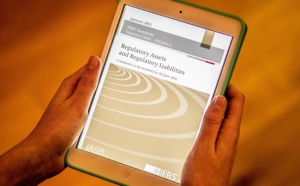عرض العناصر حسب علامة : الميزانية العمومية
الخميس, 06 يوليو 2023 11:58
رسالة ماجستير: مدى التزام الشركات المدرجة في بورصة فلسطين بمعالجة الأحداث اللاحقة لتاريخ الميزانية وفق متطلبات المعيار المحاسبي الدولي العاشر
هدفت الدراسة إلى الكشف عن مدى التزام الشركات المدرجة في بورصة فلسطين بمعالجة الأحداث اللاحقة لتاريخ الميزانية العمومية وفقاً لمتطلبات المعيار المحاسبي الدولي العاشر "الأحداث اللاحقة لتاريخ الميزانية العمومية".
نشر في
رسائل ماجستير و دكتوراة
الأحد, 03 أبريل 2022 10:14
أثر مبادئ المحاسبة على القوائم المالية
معلومات إضافية
-
المحتوى بالإنجليزية
The Effect of Accounting Principles on Financial Statements
Now that you have been introduced to many of the underlying accounting principles and concepts, let's examine what they mean for a company's financial reporting.
Distributing a complete set of financial statements
The accounting profession believes that a single financial statement is not sufficient for someone to understand a company's financial affairs. Therefore, if a company releases its financial statement(s) to someone outside of the company, it should distribute a set of financial statements containing the following:
Income statement
Statement of comprehensive income
Balance sheet
Statement of stockholders' (or owner's) equity
Statement of cash flows
Notes to the financial statements
The balance sheet reports the assets, liabilities, and stockholders' equity as of the final moment of the accounting period (December 31, June 30, etc.).
The other financial statements report the amounts that occurred throughout the accounting period shown in the heading (year ended December 31, three months ended June 30, etc.).
The notes to the financial statements are referenced on each financial statement to inform the user that the notes are an integral part of each financial statement. The notes are necessary because a company's business activity cannot be communicated completely by the amounts appearing on the face of the financial statements.
In addition to complying with US GAAP, corporations with capital stock that is traded on a stock exchange must also comply with some additional rules and communication required by the U.S. Securities and Exchange Commission (SEC). Regular U.S. corporations must also comply with federal and state income tax reporting regulations.
Accrual Method of Accounting
To properly (report) revenues and expenses on the income statement, and assets and liabilities on the balance sheet, companies must use the accrual method of accounting (or accrual accounting). The following examples illustrate accrual accounting:
Revenues are reported on the income statement when they have been earned. Generally, this means there will also be a related asset reported on the company's balance sheet, such as cash or accounts receivable. In accounting terminology, the revenues and the related asset are recognized (reported on the financial statements) when the revenues and asset have been earned.
A simple example of revenue recognition occurs when a company completes a service for $5,000 on December 28. On the same day, the company bills the customer $5,000 with credit terms of net 30 days. A month later (on January 29) the company receives the $5,000.
On December 28, the company records a $5,000 increase in its current asset account Accounts Receivable and a $5,000 increase in its income statement account Revenues Earned. On January 29, when the company receives the $5,000, it will increase its cash by $5,000 and will reduce its accounts receivable by $5,000.
Expenses are reported (recognized) on the income statement when an expense occurs. The date of the company's payment to the vendor is not relevant.
To illustrate, assume that a company incurs a $3,000 repair expense on December 26. On December 28, the company receives the vendor's invoice stating that the bill is to be paid within 15 days. On January 8, the company pays $3,000 to the vendor.
The company must record the $3,000 increase in its expenses and liabilities as of December 26 or 28. When the company pays the vendor $3,000 on January 8, the company will decrease its cash balance and will decrease its liabilities.
In short, the company's financial statements are more complete when the accrual method is used.
To comply with the accrual method, companies record adjusting entries as of the final day of the accounting period. Adjusting entries make certain that the proper amount of expenses and liabilities, and the proper amount of revenues and assets, are reported on the appropriate period's financial statements.
Revenues Reported on the Income Statement
Under the accrual method, revenues are reported or recognized on the company's income statement for the period in which the revenues were earned.
Depending on the transactions, revenues may be earned and reported on a company's income statements at any of the following times:
Before receiving the money from customers (sales and services were provided on credit)
At the time customers pay (cash sales)
After money is received from customers (some future services were required)
To achieve the accrual method, companies will make the following revenue-related adjusting entries at the end of the accounting period to:
Accrue revenues (and the related receivables) that were earned, but the company had not yet billed the customer
Defer revenues (and the related liabilities) for money received from customers, but not yet earned by the company
In 2014, the FASB issued an Accounting Standards Update (ASU) entitled Revenue from Contracts with Customers (Topic 606) which provides extensive guidance for reporting revenues on the income statement.
Expenses Reported on the Income Statement
Under the accrual method, expenses are to be reported (recognized) on the company's income statement during the accounting period in which the expenses:
Were caused by revenues (e.g., matching the cost of goods sold and sales commissions with the related revenues)
Expired or were used up (e.g., matching prepaid insurance to the accounting periods in which the prepaid amount had expired; systematically allocating the cost of equipment used in the business to the accounting periods in the equipment's useful life)
Had no future economic benefit that could be measured (e.g., advertising expense, office salaries, research expenses)
To achieve the accrual method, companies will make accrual, deferral, depreciation, and other adjusting entries for expenses at the end of each accounting period.
To learn more, visit our Explanation of Income Statement.
Assets Reported on the Balance Sheet
The cost principle (or historical cost principles) means that a company's assets are recorded at their cost at the time of the transaction. Once recorded, the cost of most assets (some marketable investment securities are an exception) will not be increased because of inflation or increases in market value.
To illustrate, assume that 18 years ago a company purchased a parcel of land for its future use at a cost of $50,000. Today, the market value of the land is $300,000. The company's current balance sheet will report the land at its cost of $50,000.
A company that sells goods will report its inventory at its cost, not at the sales value.
The cost principle prevents a company from recording and reporting its talented employees as assets. Similarly, a company's brands and logos that were developed internally and enhanced through advertising expenses cannot be reported as assets.
If an asset's fair value drops below its book or carrying value, the asset's book value may have to be decreased and an impairment loss reported on the income statement.
Liabilities Reported on the Balance Sheet
Liabilities are a company's obligations resulting from a past transaction. Typical liabilities include accounts payable, notes or loans payable, wages payable, interest payable, taxes payable, customer deposits, deferred revenue, and more.
At the end of each accounting period, there will be amounts owed by a company, but the company has not yet been billed or has not yet processed the transaction. A few examples include:
Interest on loans payable
Electricity and gas charges
Wages for hourly paid employees that have been earned but not yet processed
Repair work that was recently done by a contractor
These obligations and the related expense must be recorded for the financial statements to be complete and to comply with the accrual method of accounting. This is done with accrual-type adjusting entries.
Stockholders' Equity Reported on the Balance Sheet
Stockholders' equity or shareholders' equity is the difference between the amount of a corporation's assets and liabilities that are reported on the balance sheet. (Owner's equity is the difference between a sole proprietorship's assets and liabilities.)
Since most of a company's assets are reported at cost (or lower), the amount reported as stockholders' equity is not an indicator of the corporation's market value. Picture a service business that has developed amazing software that generates huge fees with little expenses and the owners draw out most of the profits. As a result, this service business is extremely valuable but has only a small amount reported on its balance sheet for assets and stockholders' equity.
نشر في
محاسبة و مراجعة
الأربعاء, 19 يناير 2022 07:48
مقدمة في المحاسبة المالية
معلومات إضافية
-
المحتوى بالإنجليزية
Introduction to Financial Accounting
Financial accounting is a specialized branch of accounting that keeps track of a company's financial transactions. Using standardized guidelines, the transactions are recorded, summarized, and presented in a financial report or financial statement such as an income statement or a balance sheet.
Companies issue financial statements on a routine schedule. The statements are considered external because they are given to people outside of the company, with the primary recipients being owners/stockholders, as well as certain lenders. If a corporation's stock is publicly traded, however, its financial statements (and other financial reportings) tend to be widely circulated, and information will likely reach secondary recipients such as competitors, customers, employees, labor organizations, and investment analysts.
It's important to point out that the purpose of financial accounting is not to report the value of a company. Rather, its purpose is to provide enough information for others to assess the value of a company for themselves.
Because external financial statements are used by a variety of people in a variety of ways, financial accounting has common rules known as accounting standards and as generally accepted accounting principles (GAAP). In the U.S., the Financial Accounting Standards Board (FASB) is the organization that develops the accounting standards and principles. Corporations whose stock is publicly traded must also comply with the reporting requirements of the Securities and Exchange Commission (SEC), an agency of the U.S. government.
Confused? Send Feedback
Double Entry and Accrual Accounting
At the heart of financial accounting is the system known as double entry bookkeeping (or "double entry accounting"). Each financial transaction that a company makes is recorded by using this system.
The term "double entry" means that every transaction affects at least two accounts. For example, if a company borrows $50,000 from its bank, the company's Cash account increases, and the company's Notes Payable account increases. Double entry also means that one of the accounts must have an amount entered as a debit, and one of the accounts must have an amount entered as a credit. For any given transaction, the debit amount must equal the credit amount. (To learn more about debits and credits, visit our Explanation of Debits & Credits.)
The advantage of double-entry accounting is this: at any given time, the balance of a company's asset accounts will equal the balance of its liability and stockholders' (or owner's) equity accounts. (To learn more on how this equality is maintained, visit our Explanation of Accounting Equation.)
Financial accounting is required to follow the accrual basis of accounting (as opposed to the "cash basis" of accounting). Under the accrual basis, revenues are reported when they are earned, not when the money is received. Similarly, expenses are reported when they are incurred, not when they are paid. For example, although a magazine publisher receives a $24 check from a customer for an annual subscription, the publisher reports as revenue a monthly amount of $2 (one-twelfth of the annual subscription amount). In the same way, it reports its property tax expense each month as one-twelfth of the annual property tax bill.
By following the accrual basis of accounting, a company's profitability, assets, liabilities and other financial information is more in line with economic reality. (To learn more about the accrual basis of accounting, visit our Explanation of Adjusting Entries.)
Confused? Send Feedback
Accounting Principles
If financial accounting is going to be useful, a company's reports need to be credible, easy to understand, and comparable to those of other companies. To this end, financial accounting follows a set of common rules known as accounting standards or generally accepted accounting principles (GAAP, pronounced "gap").
GAAP is based on some basic underlying principles and concepts such as the cost principle, matching principle, full disclosure, going concern, economic entity, conservatism, relevance, and reliability. (To learn more about the basic principles, visit our Explanation of Accounting Principles.)
GAAP, however, is not static. It includes some very complex standards that were issued in response to some very complicated business transactions. GAAP also addresses accounting practices that may be unique to particular industries, such as utility, banking, and insurance. Often these practices are a response to changes in government regulations of the industry.
GAAP includes many specific pronouncements as issued by the Financial Accounting Standards Board (FASB, pronounced "fas-bee"). The FASB is a non-government group that researches current needs and develops accounting rules to meet those needs. (To learn more about FASB and its accounting pronouncements, visit our www.FASB.org.)
In addition to following the provisions of GAAP, any corporation whose stock is publicly traded is also subject to the reporting requirements of the Securities and Exchange Commission (SEC), an agency of the U.S. government. These requirements mandate an annual report to stockholders as well as an annual report to the SEC. The annual report to the SEC requires that independent certified public accountants audit a company's financial statements, thus giving assurance that the company has followed GAAP.
Confused? Send Feedback
Financial Statements
Financial accounting generates the following general-purpose, external, financial statements:
Income statement (sometimes referred to as "results of operations" or "earnings statement" or "profit and loss [P&L] statement")
Statement of comprehensive income
Balance sheet (sometimes referred to as "statement of financial position")
Statement of cash flows (sometimes referred to as "cash flow statement")
Statement of stockholders' equity
Income Statement
The income statement reports a company's profitability during a specified period of time. The period of time could be one year, one month, three months, 13 weeks, or any other time interval chosen by the company.
The main components of the income statement are revenues, expenses, gains, and losses. Revenues include such things as sales, service revenues, and interest revenue. Expenses include the cost of goods sold, operating expenses (such as salaries, rent, utilities, advertising), and nonoperating expenses (such as interest expense). If a corporation's stock is publicly traded, the earnings per share of its common stock are reported on the income statement. (To learn more about the income statement, visit our Explanation of Income Statement.)
Statement of Comprehensive Income
The statement of comprehensive income covers the same period of time as the income statement, and consists of two major sections:
Net income (taken from the income statement)
Other comprehensive income (adjustments involving foreign currency translation, hedging, and postretirement benefits)
The sum of these two amounts is known as comprehensive income.
The amount of other comprehensive income is added/subtracted from the balance in the stockholders' equity account Accumulated Other Comprehensive Income.
Balance Sheet
The balance sheet is organized into three parts: (1) assets, (2) liabilities, and (3) stockholders' equity at a specified date (typically, this date is the last day of an accounting period).
The first section of the balance sheet reports the company's assets and includes such things as cash, accounts receivable, inventory, prepaid insurance, buildings, and equipment. The next section reports the company's liabilities; these are obligations that are due at the date of the balance sheet and often include the word "payable" in their title (Notes Payable, Accounts Payable, Wages Payable, and Interest Payable). The final section is stockholders' equity, defined as the difference between the amount of assets and the amount of liabilities. (To learn more about the balance sheet, visit our Explanation of Balance Sheet.)
Statement of Cash Flows
The statement of cash flows explains the change in a company's cash (and cash equivalents) during the time interval indicated in the heading of the statement. The change is divided into three parts: (1) operating activities, (2) investing activities, and (3) financing activities.
The operating activities section explains how a company's cash (and cash equivalents) have changed due to operations. Investing activities refer to amounts spent or received in transactions involving long-term assets. The financing activities section reports such things as cash received through the issuance of long-term debt, the issuance of stock, or money spent to retire long-term liabilities. (To learn more about the statement of cash flows, visit our Explanation of Cash Flow Statement.)
نشر في
محاسبة و مراجعة
الأحد, 21 نوفمبر 2021 15:23
الواقع البديل لإدارة الأرباح الحقيقية
معلومات إضافية
-
المحتوى بالإنجليزية
The Alternate Reality of REM
Real earnings management may generate short-term financial gains, but it could be concealing fraud.
Robert J. Knisley and Hui LinNovember 18, 2021Comments
Among the pandemic’s many impacts, occupational fraud risk has increased substantially in many companies and industries worldwide. Nearly three-fourths of respondents to the Association of Certified Fraud Examiners’ (ACFE’s) Fraud in the Wake of COVID-19: Benchmark Report–September 2020 Edition predicted fraudulent behavior to increase in the following 12 months.
As revenue streams and planned spending have been dramatically upended and altered, organizations have eliminated or drastically cut operational spending to account for the lost revenue. That opens the door for financial statement fraud risks. Financial statement fraud represents only 10% of fraud cases in ACFE’s 2020 Report to the Nations global study, yet it accounts for the highest median loss ($954,000). Further, such schemes can go undetected for as long as two years.
Real earnings management (REM) can be construed as a type of financial statement fraud in which managers intentionally create an alternative reality of what is going on within the organization’s accounts. With this fraud, management deviates from normal business practices to meet short-term earnings thresholds. That can delay bad news but eventually could cause a more significant market disappointment. As financial regulators increase scrutiny of companies’ earnings management practices, internal audit can help preemptively by assessing and monitoring operational decisions to ensure financial reliability and effective risk management.
REM PRACTICES RAISE RISKS
REM can raise audit concerns about a company’s accounting practices, and those practices also may have legal risks. Green Mountain Coffee Inc. is among several companies that have faced class-action securities fraud lawsuits stemming from the controversial practice of inflating product demand by building up inventory.
There are five ways that companies perform REM:
Overproduction to decrease cost of goods sold (COGS) expense.
Cutting desirable research and development expenditures.
Cutting general and administrative expenses of sales.
Timing the sale of fixed assets to report gains to boost current period earnings.
Encouraging customers to take excess inventory accompanied with unusual discounts or rights of return, also known as channel stuffing.
Internal auditors should be aware that managers’ intentions distinguish acceptable REM from fraudulent REM activities. For example, a manager may intentionally engage in fraud-ulent REM to achieve a bonus or avoid missing an earnings target. This behavior creates an alternate, fraudulent reality through a deliberate distortion of the financial statements.
THE ILLUSION OF COST-CUTTING
Auditors can better understand about REM practices by taking a closer look at how companies overproduce inventory to decrease COGS expenses. U.S. Generally Accepted Accounting Principles require absorption costing when valuing inventory for external financial reporting. This costing method allows companies to allocate the full manufacturing costs (variable and fixed) to a product.
Absorption costing occurs when a company assigns the direct material, direct labor, and manufacturing overhead to the product in the work-in-process account during production. Once the product is completed, the company transfers the cost of goods manufactured (COGM) from the work-in-process account to the finished goods account, where those costs reside on the balance sheet. When the finished product is sold, the company transfers the COGM off the balance sheet to the income statement as COGS.
Manufacturing overhead represents a significant percentage of overall manufacturing costs. In addition, management has discretion in determining a basis for allocating the overhead to the product, such as based on direct labor, machine hours, or volume. Therefore, internal auditors should be aware of the method management uses to allocate the overhead and whether it may have fraudulent implications. Auditors can learn this by asking the production manager or cost accountant about the allocation method in place and why it is used.
U.S. Financial Accounting Stand-ards Board (FASB) Statement of Fin-ancial Accounting Standards No. 151 provides discretion by allowing companies to account for normal excess capacity under absorption costing. However, FASB does not clearly define what constitutes normal excess capacity. This discretion provides managers an opportunity to increase manufacturing production above normal capacity — what the company is normally able to sell — to achieve analyst earnings per share, annual bonus, or enhanced financial statement performance expectations.
Although the organization’s financial statements are strengthened in the short term, the additional inventory can have an adverse long-term effect by eroding firm value and brand image. Internal auditors should determine whether the company has significantly built up inventory that exceeds planned production or forecasted sales. Such an increase would affect the inventory account on the balance sheet and the COGS account on the income statement, providing a red flag. Further, auditors should investigate the associated expenses related to the excess inventory, such as storage and insurance expenses, which would not have been incurred otherwise.
INTERNAL AUDIT AND FRAUD DETECTION
Internal audit is well-suited to examine management’s business decisions as well as investigate REM and its fraud potential. However, auditors may struggle to detect managerial intentions because of REM’s opaque nature and ability to be disguised as actual operational decisions. That is particularly unfortunate in the manufacturing industry, which suffers among the highest median losses from a case of financial statement fraud ($198,000), according to the ACFE’s Report to the Nations.
Internal auditors can use their broad access to organizational systems and many areas of the business to detect fraudulent REM activities such as overproduction of inventory. Those efforts may be helped by three types of analysis tools:
Horizontal analysis. Considers the financial performance of an account over time.
Vertical analysis. Compares the financial performance of an account to a base amount in a particular year.
Ratio analysis. Measures the relationship between financial statement accounts.
Internal auditors should use these three analysis tools together to identify areas of fraud risk and potential red flags in the financial statements. They can use horizontal analysis to compare the current balance of the inventory account to previous quarters and years. For example, if the inventory account is growing significantly over time without irregular sales volume, it could indicate there is inventory buildup for fraudulent reasons.
Vertical analysis, or common size analysis, is most useful when comparing industry benchmarks or competitors’ financial statement accounts. Common-sizing involves dividing each account into a base number — that is, the total assets for the balance sheet and revenues for the income statement — thereby showing each account as a percentage of the base number. By common-sizing the financial statements, it becomes easy to measure the relative importance of each account and provides an opportunity to compare companies of different sizes. For example, is the organization’s COGS account significantly less than industry benchmarks or competitors?
Finally, ratio analysis is helpful in measuring the relationship between the balance sheet and income statement accounts. Two ratios that would be of interest are inventory turnover and day’s sales in inventory. The inventory turnover ratio — the COGS divided by the average inventory — indicates the number of times an organization goes through its inventory in a year. If this ratio has decreased significantly over time, it could indicate an excessive buildup of inventory.
The day’s sale of inventory provides information on how much inventory an organization has available. It is calculated by dividing the ending inventory by the COGS and then multiplying by 365. A dramatic increase in this ratio could indicate an inventory issue.
Besides these analysis tools, internal auditors should monitor the organization’s budget-to-actual report monthly to identify any significant changes in inventory-related accounts. Furthermore, where analysis shows accounts with red flags, auditors should investigate further by performing more substantive tests of analytical procedures and the details of transactions and balances, as well as questioning operational personnel. Additionally, internal auditors should review the controls over manufacturing production and examine the master budget and its components. If internal auditors are familiar with REM and can detect when it is practiced, they can investigate whether the intention is to mask declining sales and report what they discover to management and those charged with governance.
THE SIGNS OF FRAUD
Buildup of inventory could be attributed to slumping sales or intense competition from competitors, rather than fraud. Being able to distinguish between fraudulent and legitimate practices is one reason why internal auditors should possess a solid understanding of their organization and the industry in which it competes.
Likewise, auditors should know what pressures and incentives influence managers’ behaviors and, ultimately, their decision-making. Analyst expectations and managerial compensation incentives can motivate managers to commit financial statement fraud through an REM fraud scheme. In turn, the manager’s REM decisions to increase manufacturing production intentionally deceive analysts, shareholders, and creditors. Such temptation is even more reason for internal auditors to take extra steps to help safeguard their organizations against fraudulent schemes in these volatile and uncertain economic times. - البلد الأردن
نشر في
موضوعات متنوعة
الخميس, 04 مارس 2021 12:57
الشركات التي تستثمر في العملات المشفرة تتعرض لمفاجأة محاسبية
معلومات إضافية
-
المحتوى بالإنجليزية
Companies investing in crypto may be in for a rude accounting surprise
By Michael Cohn
February 25, 2021, 4:44 p.m. EST
6 Min Read
Facebook
Twitter
LinkedIn
Email
Show more sharing options
Corporations are starting to buy digital assets like Bitcoin to bolster their treasuries, but the volatility in prices could put a dent in their balance sheet.
A new report from Deloitte examines the trend of companies allocating their funds toward buying virtual currency and other digital assets. The business intelligence software company MicroStrategy, for example, disclosed in December that it purchased over $1 billion in Bitcoin in 2020. This month, car maker Tesla announced it bought $1.5 billion in Bitcoin and will accept it as a payment. Tesla CEO Elon Musk has also tweeted about his investments in the digital currency Dogecoin. Twitter too is reportedly mulling the purchase of Bitcoin to boost its reserves, while Twitter CEO Jack Dorsey said in 2019 that he has been purchasing $10,000 in Bitcoin each week. The Deloitte paper offers guidance to companies on investing in digital currencies for their treasuries, including the accounting and reporting considerations, tax implications, risks and internal controls.
The most commonly accepted accounting treatment for cryptocurrencies in the U.S. requires writedowns of losses, which can be common given the volatility of many digital currencies, but the rules don’t permit “writeups” of gains. That could potentially mislead investors when they’re reviewing financial statements, so companies may need a stronger non-GAAP financial disclosure system to keep investors informed about digital assets that are gaining in value.
Managing Your Firm in a Post-COVID World
Think beyond the pandemic with exclusive resources to help you build a thriving virtual practice.
SPONSORED BY INTUIT ACCOUNTANTS
“For most companies in the U.S., U.S. GAAP accounting rules really require you to account for those investments like an intangible asset,” said Amy Park, an audit partner in Deloitte’s national office for accounting and reporting services who specializes in consolidation, financial instruments and digital assets, who co-wrote the report. “If you think about how some of these companies are using this, they’re looking at this as a form of investment. That may be a little counterintuitive, but in the accounting rules, you have to look at the specific definitions. When you look at the definition of a cash equivalent, or inventory, or financial instruments per se, the accounting definitions don’t really line up with what Bitcoin is. It really falls into this intangible model.”
Companies typically have to account for an intangible asset initially at cost, which is probably the fair value of what they’ve paid for it on day one. “You have to assess that asset for potential impairment, but not like other financial instruments,” said Park. “You don’t get to really mark-to-market, or account for the appreciation in value related to that asset.”
Unlike a traditional company stock investment, companies need to treat cryptocurrency differently. “I usually will think of the value I can sell it to somebody else in the marketplace as what it’s worth to me today,” said Park. “The accounting for that financial asset or financial instrument is mark-to-market, so if the value goes up or the price goes up, I can mark it up on my balance sheet. As the price goes down, I can mark it down on my balance sheet. But with the intangible asset, you’re not in that model, so as the price goes up, you don’t get to recognize any of that appreciation on your books. As the price goes down, if it’s impaired, you do have to reflect that on your books, so you sometimes end up with the downward adjustments, but no potential upward adjustments, which can be challenging because I think some companies are viewing this as very similar to an investment or a financial asset but the accounting doesn’t allow that.”
That means companies may not be getting what they bargained for when they made the decision to invest in cryptocurrency in the hopes of growing their assets. “For companies who are looking at Bitcoin as a form of investment, who are looking to hold it over the long term, and the price is potentially going to go up over the longer term, not necessarily day trading per se, I think a lot of those companies may feel like they should get the benefit of writing it up when the value goes up, and writing it down when the value goes down, but the accounting model doesn’t allow for that,” said Park.
Companies will also need to be aware of the tax rules. In general they don’t need to pay taxes on the holdings, only when they sell the cryptocurrency. “It’s only when you convert it back to fiat [currency] that you have a taxable event, but the tax rules are complicated in a way that does not track the accounting rules,” said Tim Davis, a principal in the risk and financial advisory practice of Deloitte & Touche. “This is kind of a lesson to learn for companies. It’s really important to understand the tax obligations because they can change depending on your intent. You can have the same cryptocurrency, but depending on how you’re using it and your intent for it, it could end up being taxed differently, which is true in other areas as well, but it’s particularly true in this case.”
Companies will need to be careful in how they are tracking the digital assets for tax purposes. “On the tax side some of the difficulty is that you’re dealing with an asset that’s sometimes fungible, so when you have a realizable taxable event — when you’re converting it into cash or ultimately selling it — really being able to identify your basis in that asset can be challenging depending on how operationally you’ve structured your wallet to make sure that you’re appropriately segregating different assets that came onto your tax books at a certain cost basis,” said Park.
The IRS has added questions to the Form 1040 on the individual tax side asking about cryptocurrency holdings and sales. The Securities and Exchange Commission has also been keeping a close eye on cryptocurrency, especially initial coin offerings that may be fraudulent.
“The SEC has not really been dissuading companies from investing in this, but the SEC continues to have a very strong retail protection mandate, and that’s true here,” said Davis. “They do want to make sure that the retail investor has adequate disclosures relative to making investment decisions. There is still a fair amount of uncertainty around how the rules are getting applied relative to when a cryptocurrency is being considered a security. There are ongoing lawsuits with the SEC right now. As we get more and more of this, it will continue to clarify the legal precedent around under what circumstances a cryptocurrency can and should be considered a security.”
Companies will probably need to be careful, especially if they’re thinking of getting involved in an ICO. “One caution for companies that are selecting cryptocurrencies is they may want to get legal advice, particularly if there is some sort of a capital generation event like an initial coin offering where the founders are actually raising money and you’re buying into the cryptocurrency as part of that funding round,” said Davis. “It might be advisable that you get your own legal counsel input on whether this represents any risk that it might actually be a distribution of what would then be an unregistered security. Obviously if that were to be the case, after the fact, it would likely significantly impair the value of that investment.”
Other regulatory agencies, such as those overseeing banks, also have anti-money laundering and Know Your Customer controls in place over the sourcing of cryptocurrencies, and in that case it’s a good idea to work with a reputable exchange. “Typically if the company buys cryptocurrency from a reputable cryptocurrency exchange, that exchange will have robust AML and KYC checks, so they can be fairly well assured that those steps are happening before they’re acquiring,” said Davis.
نشر في
موضوعات متنوعة
موسومة تحت
الإثنين, 01 مارس 2021 14:35
اجعل الأصول غير الملموسة ذات أهمية
معلومات إضافية
-
المحتوى بالإنجليزية
The unbalanced balance sheet: Make intangibles count
By Wes Bricker
February 24, 2021, 10:48 a.m. EST
3 Min Read
Facebook
Twitter
LinkedIn
Email
Show more sharing options
Change and uncertainty are a feature of our world alongside innovations in our fast-changing economy. Investments in new business models and intangible assets — such as brands, technology and customer relationships — are increasingly key to driving value creation as companies research new technologies, cultivate customer relationships, manage their workforce and more. But information related to these important assets is often limited in the financial information reported by companies to stakeholders.
Intangibles are often unique, but that doesn’t mean it’s impossible to integrate intangible assets in reporting efforts. The lens through which we view a company affects how we measure success. A more complete picture contributes to a more unified understanding of value and, when used wisely, can act as a clear signal for action.
So what is the current state of affairs, and what can be done to improve things?
Why accounting lags behind
Accounting standards have historically treated investments in plant and equipment or financial assets very differently than investments in intangibles. As a result, investments in internally generated intangible assets are generally not recognized on balance sheets. This may have been OK at a time when companies created value through the deployment of vast collections of tangible assets, but today, most companies generate much of their value through intangible assets. The absence of most intangibles from financial statements and footnotes can result in a large gap between the book value of the company and its market capitalization, as well as a GAAP earnings metric that does not reflect a complete measure of return on investment.
Approach intangible assets with the rigor of financial reporting
To enhance the relevance of financial reporting, it needs to provide greater insight into intangible investments. Communicating this information as part of the financial reporting process, rather than through other avenues, subjects it to the rigor of the financial reporting ecosystem. Including information on internally generated intangibles, in addition to any acquired intangibles, can help incorporate some measure of intangible assets’ value into a company's financial statements.
Don’t stand still on ESG while things change around you
Investors are increasingly focused on a company’s environmental, social and governance (ESG) strategy, which highlights management’s stewardship of certain intangibles, such as human capital. ESG is a lens to help understand the operational and financial measures of impact and value creation. Operational and financial dimensions are linked — use both perspectives for a more comprehensive view of performance. ESG strategies and high-quality data can help you understand the impact of activities, and trigger decisions, change and financial outcomes. Stakeholders today are seeing a greater connection between ESG strategies and long-term value creation, and rewarding it. Strategies and commitments need milestones and a well-considered selection of high-quality ESG measures to communicate performance. This ESG data often includes operational insights (such as customer retention rates) that translate into value (valuation of customer intangibles).
Standardized disclosure guidelines will help
Transformational changes to financial statements, such as recording and disclosing all or some internally generated intangibles, will help the financial reporting process keep pace with business innovation and remain relevant. Thankfully, FASB and IASB recognize the need for action in this area. FASB is in the early stages of a project, and the IASB is seeking feedback from stakeholders on adding one. In the meantime, it’s critical for boards to engage all stakeholders — from the C-suite to regulators, auditors and users — to gather each of their unique perspectives on how financial reporting can best capture the value created through intangible assets.
Ultimately, ensuring that stakeholders have visibility into management’s stewardship over intangible assets is critical if financial reporting is to remain relevant in an intangible-dominated world. While the best approach may not be one-size-fits-all, any reliable effort to incorporate valuable intangible assets will benefit businesses in the long run.
نشر في
موضوعات متنوعة
الأربعاء, 10 فبراير 2021 14:36
المحاسبة الحكومية عند مفترق طرق: الفرص الناشئة خلال COVID-19
معلومات إضافية
-
المحتوى بالإنجليزية
Government accounting at crossroads: Emerging opportunities during COVID-19
ED OLOWO-OKERE|FEBRUARY 05, 2021
Government accounting and financial reporting are at a crossroads today. Providing information on how much cash is received into treasuries and paid out for goods, services and transfers is not enough. Stakeholders are demanding more accountability and engagement in public finances. Governments are spending large sums of money to tackle the health emergency and to implement massive fiscal stimulus programs in response to the pandemic. Undoubtedly, timely and quality information is necessary to better assess the financial health of governments and to communicate the financial consequences of the pandemic to all stakeholders. This can contribute to building the much-needed trust in governments and improve the effectiveness of their pandemic response.
The World Bank’s recent paper on the role of Government Financial Reporting in times of the COVID-19 Pandemic provides guidance to accountants and auditors on identifying opportunities to improve financial reporting within the existing systems. The paper also highlights the impact of the pandemic on government financial performance, position and cash flows.
Similarly, the International Public Sector Accounting Standards (IPSAS) Board and International Federation of Accountants (IFAC) released a COVID-19 Intervention Assessment Tool, which helps assess, evaluate and inform various types of interventions by governments. Another recent study by the Association of Chartered Certified Accountants (ACCA) on Sustainable Public Finances through COVID-19 highlighted the critical need to record and manage the assets and liabilities being created through the below-the-line policy measures, such as guarantees and equity injections.
Some of the emerging lessons on government financial reporting during the COVID-19 crisis include the following:
Financial statements information has been traditionally underutilized by governments. Going forward, balance sheet information can inform how to achieve an inclusive and sustainable recovery in the post COVID-19 world.
Government accountants should more proactively demonstrate the value of financial statement information and why it should be analyzed in conjunction with statistical information.
While ‘accrual basis accounting’ is necessary to prepare financial statements that provide a comprehensive overview of the impact of COVID-19, jurisdictions following ‘cash basis accounting’ can enrich their financial statements with supplementary information for better decision making.
Comprehensive financial statements based on accrual-based accounting will contribute to debt transparency and improved decision making. For example, in the current situation where global public debt is projected to approach a record high in 2021, countries need to closely monitor their sources of funding and associated costs. Comprehensive financial statement information on debt is especially useful for making policy decisions.
Annual and interim financial statements should be prepared on a timely basis in order for them to be useful to policy makers and help inform pandemic-related response financial decisions.
Countries need to accelerate implementation of accrual-based accounting and financial reporting reforms, preferably aligned with the International Public Sector Accounting Standards (IPSAS) , to have more comprehensive and reliable financial information for decision making.
Ministries of Finance need to ensure that the necessary systems and procedures, including Integrated Financial Management Information Systems (IFMIS) implementation, are in place to facilitate the recording of transactions and preparation of financial statements. These include consolidated ones with different levels of aggregation and even the whole-of-government financial statements where feasible
Financial statements that include information on the long-term fiscal sustainability, with a focus on the impact of the pandemic, are necessary.
Strong coordination by the Ministry of Finance and Accounting Agencies with the auditors of government financial statements, i.e. Supreme Audit Institutions (SAIs), is critical. This is not only with respect to the preparation of audited financial statements but also in developing and implementing accounting and financial reforms such as migration to accrual-based accounting.
Accounting and auditing agencies should regularly conduct business continuity assessments so that governments are ready to face future emergencies without detrimental effects on their operating capacity , and that essential and non-essential staff can work remotely when needed.
The COVID-19 pandemic has changed the world and how governments operate forever. By strengthening public financial management systems and protocols today, governments will be better prepared for an increasingly uncertain tomorrow.
نشر في
موضوعات متنوعة
الأربعاء, 28 سبتمبر 2022 12:09
مجلس معايير المحاسبة الدولية (IASB) يقترح معيارًا جديدًا
يقترح مجلس معايير المحاسبة الدولية (IASB) معيارًا جديدًا للمعايير الدولية لإعداد التقارير المالية (IFRS) لمنح المستثمرين صورة أكثر اكتمالاً عن الأداء المالي
معلومات إضافية
-
المحتوى بالإنجليزية
IASB proposes new IFRS Standard to give investors a more complete picture of the financial performance of rate-regulated companies
The International Accounting Standards Board (Board) has today published proposals for a new accounting standard that would require companies subject to rate regulation to give investors better information about their financial performance.
Rate regulation, which is common in some industries, including the utilities and public transport industries, determines the amount a company can charge its customers for goods or services supplied to them and the period when the company can charge that amount.
In some cases, the period when a company supplies goods or services differs from the period when the company can charge customers for those goods or services—and thus differs from the period when the company reports revenue in its income statement.
When those differences in timing occur, the revenue a company reports for a period in its income statement and the assets and liabilities it reports in its balance sheet do not give a complete picture of the amount that the rate regulation entitles the company to charge for goods or services supplied in that period.
Currently, IFRS Standards do not require companies to give investors information about those differences in timing.
The proposed Standard would introduce a requirement for companies to give investors such information by reporting regulatory assets and regulatory liabilities in their balance sheet, and related regulatory income and regulatory expense in their income statement.
This information would complement the information companies already provide applying current IFRS Standards and give investors a more complete picture. The additional information would help investors understand which fluctuations in the relationship between a company’s revenue and expenses are caused by differences in timing and enable investors to make better assessments of the company’s prospects for future cash flows.
Hans Hoogervorst, Chair of the Board, said:
Rate regulation can have a big impact on a company’s revenue and profit, but currently investors don’t get the full picture of this impact. Our proposed new IFRS Standard will require additional information to give investors a more complete picture.
The proposed Standard would replace IFRS 14 Regulatory Deferral Accounts.
Access the Exposure Draft Regulatory Assets and Regulatory Liabilities consultation. The deadline for comments is 30 June 2021.
نشر في
محاسبة و مراجعة
موسومة تحت
الإثنين, 23 مايو 2022 14:49
إنفوجرافيك.. مؤشرات الأداء الرئيسية لأصحاب شركات المحاسبة
نشر في
إنفوجرافيك
موسومة تحت
الثلاثاء, 27 أكتوبر 2020 11:30
مؤشرات الأداء الرئيسية لأصحاب شركات المحاسبة
نشر في
موضوعات متنوعة
موسومة تحت










